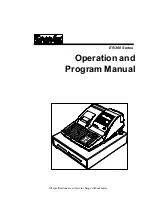
SAM4S ER-900 Series Electronic Cash Register AU
Service Mode Programming
•
101
Memory Allocation
The memory allocation program determines how memory is divided to support the following features:
1.
PLUs - You must allocate a minimum number of PLUs which match the number of NLU in
your ECR. Please refer to the table in step 4 on the next page for maximum number of PLU
for your model. The maximum number of PLU is based on
full load memory
. Please contact
your dealer for detail. Standard machine have 2000 PLU spaces (300 PLUs has been pre-
programmed) preset, maximum is 15,000.
2.
Clerks - You must allocate at least
1 clerk
, with a maximum of 99.
NOTE: you also must allocate at least one guest check for each clerk.
3.
Groups - You must allocate at least
1 group
, up to maximum of 99.
4.
Checks - You must allocate number of Guest Check to
at least
match number of clerk.
Otherwise, you can allocate a maximum of 500 hard or soft checks. The maximum
number of Guest Checks is based on
full load memory
.
5.
Soft Check Lines - You can allocate a maximum of
200 lines
per check
6.
Check Type - Select hard or soft checks.
7.
Levels - Allocate one or two price levels.
8.
Mix & Match Discount Tables - Default is 10 you can allocate a minimum of 0 to a
maximum of 100.
9.
Electronic Journal - Default is 0 lines; maximum is based on the remaining memory space
available.
Important Memory Allocation Notes
a.
Memory variable maximums are dependent. For example, if all other variables are at or
near zero, then you may allocate more PLUs.
NOTE: check memory, especially
soft check
memory, and
clerk memory
consume
considerable memory.
b.
Using the clerk interrupt feature requires allocation of at least one guest check for each
clerk and sufficient soft check lines to support the interrupted transaction (i.e. if soft
check lines allocated is 20, a transaction with up to 20 lines can be interrupted.) See
System Option
address #26 to select clerk interrupt operations instead of table
management (check tracking) operations.







































